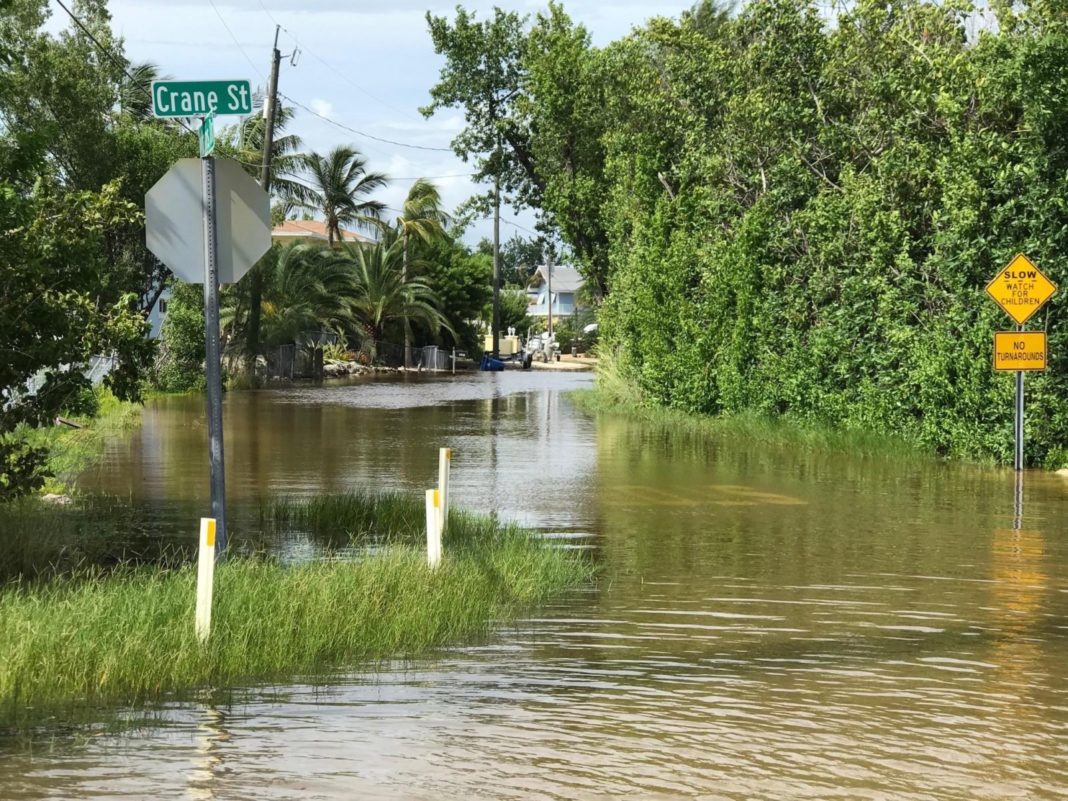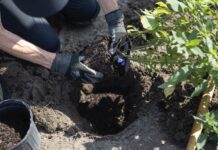A pilot project aiming to address long-standing flood issues in one Key Largo community needs $7.1 million. Budget constraints due to COVID-19 and uncertainties over grant awards, however, leave a project once thought to be a model for future sea level rise projects in limbo.
Among the roads in the Keys subject to high waters from king tides and heavy storms are those in the Twin Lakes community at MM 103 in Key Largo. Talks date back 10 years when concerns rose over sea level rise and the need for a resolution over inundated roads. Fast forward to late 2015 and early 2016, when Twin Lakes residents dealt with more than a month of sustained and continuous saltwater flooding.
That led the board of county commissioners to make Twin Lakes and the Sands subdivision in Big Pine Key as the pilot project to study, design and implement a solution to address flooding issues. Commissioners in January 2017 received an engineer’s report and recommendations on a design. It included elevation of roads within Twin Lakes to about 5 inches of elevation to extend the life of the road to 2040. Roads identified included Shaw Drive, Crane Street and Adams Drive. As for the Sands Division, the report recommended a road elevation to about 11 inches.
A resolution was subsequently approved to adopt the report, move forward with a design phase and budget funds in the 2017-18 budget. In 2018, the commission approved a contract with WSP USA Inc. for engineering design and permit services for the seal level rise pilot project in an amount not to exceed $517,518.04.
With studies and reports complete, and time and money spent, funding is the next critical step. But as the public and commissioners heard during a Sept. 8 budget hearing, the Twin Lakes and Sands Subdivision pilot project was in a list of infrastructure projects not currently funded.
“These are projects that we’ve been talking about that aren’t funded,” said Tina Boan, county director of budget and finance. “On most of these projects, we have applied for grant funding whenever we can, and then we hope we can cover our portion of it.”
Boan said the question commissioners must think about is how to pay for multimillion-dollar projects like Twin Lakes and Sands. Options included non-ad valorem special assessments, a stormwater utility fee, a debt service that can be changed in the ad valorem, or a toll on U.S. 1.
Judy Clarke, director of engineering services, told commissioners at the Sept. 16 regular meeting that the combination of the two projects after the pilot study had construction at $3.5 million. Now, through full design, the combination of the two is about $14 million.
“It’s considerably more than our normal roadway project. … $7 million is the most expensive roadway project I’ve done in the county to date,” Clarke said. “I would mention, too, that before we knew higher costs, staff applied for grants. It’s always part of our game plan.”
Stephanie Russo is a resident of the Twin Lakes subdivision who knew nothing about the tidal flooding when she bought her home years ago. With initial work already complete on the pilot project and the board’s intent to pay for construction — as evidenced by the inclusion of project construction costs in the 2018, 2019 and 2020 capital budgets — Russo said she’s concerned the county is looking to lump the project in with a countywide analysis of roads that’s underway and expected to come out in March 2021.
“The board intended to complete the construction of the pilot project before adopting the county-wide plan. That is why it was the ‘pilot’ project,” Russo wrote in a letter to the BOCC. “Commissioners, at the Sept. 3 meeting, said this pilot project needs to be completed, and funds identified now, so that the results and lessons learned can be used to inform the future countywide plan, and directed staff to look at the tentative budget for projects that could be delayed to divert at least some funds towards the construction costs.
“Staff came back to you on Sept. 8, 2020, and while they identified projects that could be delayed, they told you that they do not think the pilot project should be prioritized over any of these projects,” she continued. “In fact, not only do they not think any money in the budget should be directed to the pilot project, they also do not think other sources of funding specifically for the pilot project should be identified now.”
During budget meetings on Sept. 3 and 8, commissioners Craig Cates and Michelle Coldiron said the county must move forward with the pilot projects and find resources to fund them.
“Especially the ones promised here in the county,” Cates said. “These projects just can’t keep being put off.”
“We can’t keep kicking this can down the road,” Coldiron said.
As Boan stated during the Sept. 8 presentation, revenues have taken a hit due to the ongoing coronavirus pandemic — somewhere to the tune of $13 million lost this year.
“The county commission doesn’t have the flexibility that they would normally have,” she said. “It’s very uncertain.”
Assistant County Administrator Christine Hurley said the county is seeking grant opportunities for projects like Twin Lakes through the state Department of Economic Opportunity and FEMA’s new Building Resilient Infrastructure in Communities (BRIC) program, among other sources.
“It seems like FEMA is going to focus on using mitigation money for infrastructure, which in the past, the proactive FEMA programs haven’t really done,” she said in relation to the new FEMA program. “That we think is going to be a good opportunity for the county.”
Russo said the benefits of the pilot project are not limited to the Twin Lakes and Sands communities. Rather, the pilot project has a wide public benefit as it will be used to make intelligent decisions on future planning. The county has spent more than half a million dollars on the pilot project, and every dollar will have been wasted if the project is delayed and lumped together with the county-wide project, she said. Commissioners are set to convene for a regular meeting and budget hearing on Sept. 16.
“I understand the budgetary constraints caused by the pandemic, and that some public-private partnership may be necessary to fund the construction,” she said. “However, in my opinion, any commissioner who cannot find a single penny in the budget for this project, or doesn’t think the project should be completed first rather than delayed and included in the county-wide plan, frankly, does not have our county’s best interest in mind.”
A workshop meeting is being planned for November to discuss a plan forward.


























